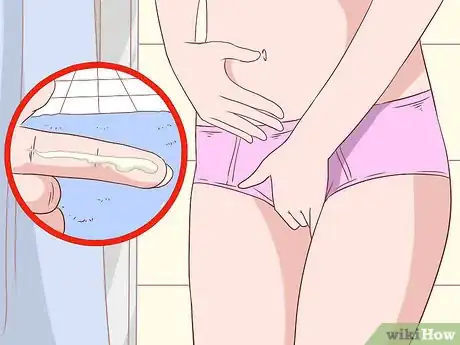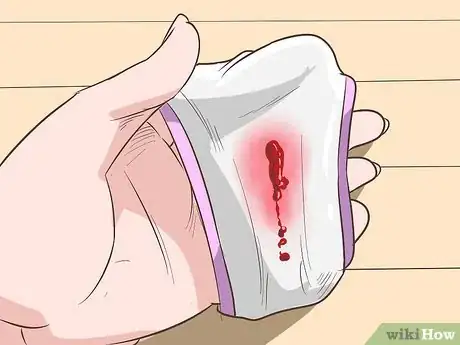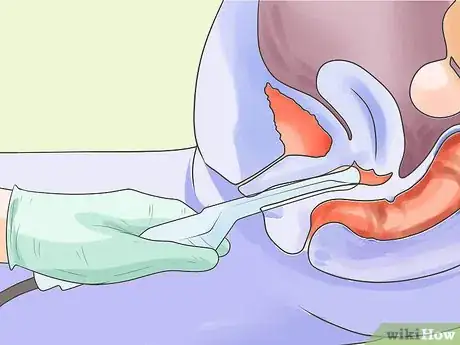This article was medically reviewed by Luba Lee, FNP-BC, MS. Luba Lee, FNP-BC is a Board-Certified Family Nurse Practitioner (FNP) and educator in Tennessee with over a decade of clinical experience. Luba has certifications in Pediatric Advanced Life Support (PALS), Emergency Medicine, Advanced Cardiac Life Support (ACLS), Team Building, and Critical Care Nursing. She received her Master of Science in Nursing (MSN) from the University of Tennessee in 2006.
There are 10 references cited in this article, which can be found at the bottom of the page.
This article has been viewed 99,146 times.
Cervicitis is a condition characterized by discharge and inflammation in the cervix, the thickened tissue that connects the uterus to the vagina. Cervicitis is usually caused by sexually transmitted diseases, particularly chlamydia and gonorrhea. More than half of all women will experience cervicitis at least once. While some women experience no symptoms with cervicitis, others may have abnormal vaginal discharge or bleeding after sexual intercourse. If you have cervicitis, it is important to recognize and treat the cervicitis and the infections that typically occur with it; otherwise, it could lead to infections in the uterus, fallopian tubes, or ovaries. Over time, cervicitis that is left untreated can cause pelvic inflammatory disease (PID) and infertility.
Steps
Recognizing the Symptoms of Cervicitis
-
1Check for abnormal vaginal discharge. Healthy women have vaginal discharge, which can vary in color, amount, and consistency over the course of the menstrual cycle. Abnormal discharge, however, can indicate cervicitis or another problem, so make an appointment with your doctor.[1]
- Because vaginal discharge can vary so much, “abnormal” can mean a variety of things and can be defined differently by different women. That said, pay particular attention to any vaginal discharge with an unusual odor, color, or appearance.
-
2Watch for spotting between menstrual periods and after sex. Bleeding between your menstrual periods, or after sexual intercourse, could be a sign of cervicitis. Because the tissue is more delicate, an inflamed cervix bleeds more easily than a normal cervix. Call your doctor if you notice this symptom.[2]
- You may notice, in particular, that you have spotting after sexual intercourse. This can also be a symptom of cervicitis. Spotting during sexual intercourse can be a symptom of other issues besides cervicitis so you should get it checked regardless.
Advertisement -
3Check for pain during sexual intercourse. Pain during intercourse, also known as dyspareunia, is a common symptom and can indicate a variety of problems, including cervicitis. Make an appointment with your doctor to discuss the issue (along with any other symptoms you may have). There’s no reason to assume that pain during intercourse is normal or unavoidable.[3]
-
4Look for a feeling of heaviness in your lower abdomen. Some women with cervicitis experience an uncomfortable feeling of bloating, pressure, or heaviness in the lower abdomen. Make an appointment with your doctor if you have this problem.[4]
- Heaviness in your lower abdomen can be a symptom of other medical issues. You should get it checked out whether or not you suspect you may have cervicitis.
-
5Know the common symptoms of co-infections. Women with cervicitis sometimes experience related inflammation in the vagina (causing vaginal itching, dryness, and discomfort during intercourse) or urinary tract (causing frequent urination, painful urination, and, sometimes, blood in the urine).[5]
- These symptoms are not technically signs of cervicitis itself, but they do suggest co-infections, so see your doctor regardless.
-
6Be aware of the less common symptoms of cervicitis. In addition to the symptoms above, there are some signs of cervicitis that occur very rarely, usually only in those few cases in which an infection starts as cervicitis as then spreads to the rest of the body. These symptoms include:[6]
- Nausea
- Vomiting
- Diarrhea
- A general feeling of sickness
Diagnosing Cervicitis
-
1Make an appointment with your doctor. Do not attempt to diagnose cervicitis yourself. The symptoms are easily confused with other conditions, such as yeast infections, and more importantly, your cervicitis may have developed because of a serious infection, like an STI, which requires medical treatment.[7]
-
2Get a pelvic exam. Your doctor will likely perform a pelvic exam as a first step in diagnosing cervicitis. They will insert a speculum and observe your cervix, making note of any redness, ulcerations, inflammation, swelling, or abnormal discharge.[8]
-
3Schedule lab tests. If your pelvic exam reveals signs of cervicitis, your doctor will order applicable lab tests, including a culture of your cervical discharge, a culture of the cervical cells themselves, and, if you are sexually active, tests for gonorrhea, chlamydia, and other sexually transmitted infections.[9]
- Depending on the results of these tests, understand that your doctor may order additional testing, including a possible biopsy or colposcopy (an examination with a special magnifying device) of the cervix.
-
4Get a diagnosis from your doctor. There are two basic categories of cervicitis: infectious and non-infectious. Infectious cervicitis is much more common than non-infectious cervicitis. Your doctor will tell you which type you have.[10]
- Infectious cervicitis develops due to a sexually transmitted infection (STI) like gonorrhea or chlamydia. The association between these STIs and infectious cervicitis is so strong, in fact, that your doctor may start treating you for STIs immediately, even before the specific diagnosis is confirmed.
- Non-infectious cervicitis is much less common. Causes include foreign objects, such as intrauterine devices (IUDs) and cervical caps; allergic reactions to latex, which can develop after intercourse using latex condoms; and douches and other vaginal washes.
- Your doctor may also refer to “acute” or “chronic” cervicitis. In general, acute cervicitis is infectious; chronic cervicitis is non-infectious.
Treating Cervicitis
-
1Take prescribed medication. For infectious cervicitis, your doctor will probably prescribe antibiotics to treat infections like chlamydia or gonorrhea. Antiviral medications may be prescribed to treat conditions like genital herpes. They may also recommend taking hormones like progesterone and estrogen or, in rare cases, glucocorticosteroids, to help with inflammation.[11]
- Side effects of these medications include nausea, upset stomach, and fatigue. Your doctor should outline the side effects of these medications before prescribing them to you.
-
2Consider electrocauterization. For non-infectious cervicitis, antibiotic and antiviral medications will not eliminate the problem. Therefore, your doctor may suggest one of three surgical treatment options. The first, electrocauterization, is a surgical procedure in which a doctor removes unwanted tissue with electricity.
-
3Discuss cryosurgery with your doctor. Your doctor may also recommend cryosurgery for cases of non-infectious cervicitis. Cryosurgery (a word that comes from the Greek for “icy hand work”) involves the use of extreme cold to “freeze off” or eliminate abnormal tissue.[12]
-
4Consider laser therapy. Your doctor may also recommend laser therapy for cases of non-infectious cervicitis. Laser therapy is the use of intense beams of light to burn, destroy, or precisely cut unwanted tissue.[13]
-
5Avoid irritating your vagina. While pursuing treatment options with your doctor, you can also take steps to minimize your discomfort. Avoid anything that might irritate your vagina or cervix: douches, vaginal rinses, harsh soaps, and sexual intercourse should all be eliminated.[14]
-
6Abstain from sex until your treatment is complete. Depending on what kind of treatment you receive for your cervicitis, you may need to abstain from sex for up to a week after your therapy is done. Ask your doctor how long you should wait before having sexual intercourse again.[15]
-
7Inform your sexual partners. If your cervicitis is infectious, make sure your sexual partners also seek treatment. Be aware that even if they have no symptoms, they can be infected, and they can re-infect you, even after you’ve followed the treatment regimen recommended by your doctor.[16] For these reasons, it is important for both your health and that or your partner(s) that they seek treatment as well.
References
- ↑ https://www.merckmanuals.com/professional/gynecology-and-obstetrics/vaginitis,-cervicitis,-and-pelvic-inflammatory-disease-pid/cervicitis
- ↑ https://www.hopkinsmedicine.org/health/conditions-and-diseases/cervicitis
- ↑ https://my.clevelandclinic.org/health/diseases/15360-cervicitis
- ↑ https://medlineplus.gov/ency/article/001495.htm
- ↑ https://medlineplus.gov/ency/article/001495.htm
- ↑ https://emedicine.medscape.com/article/253402-treatment
- ↑ https://emedicine.medscape.com/article/253402-overview#showall
- ↑ https://www.hopkinsmedicine.org/health/conditions-and-diseases/cervicitis
- ↑ https://www.hopkinsmedicine.org/health/conditions-and-diseases/cervicitis
- ↑ https://my.clevelandclinic.org/health/diseases/15360-cervicitis
- ↑ https://emedicine.medscape.com/article/253402-treatment#d9
- ↑ https://www.jstage.jst.go.jp/article/iryo1946/28/3/28_3_243/_article
- ↑ https://my.clevelandclinic.org/health/diseases/15360-cervicitis#management-and-treatment
- ↑ https://medlineplus.gov/ency/article/001495.htm
- ↑ https://www.merckmanuals.com/professional/gynecology-and-obstetrics/vaginitis,-cervicitis,-and-pelvic-inflammatory-disease-pid/cervicitis
- ↑ https://my.clevelandclinic.org/health/articles/cervicitis






-Step-10.webp)

-Step-11-Version-3.webp)
-Step-10-Version-2.webp)































































Medical Disclaimer
The content of this article is not intended to be a substitute for professional medical advice, examination, diagnosis, or treatment. You should always contact your doctor or other qualified healthcare professional before starting, changing, or stopping any kind of health treatment.
Read More...